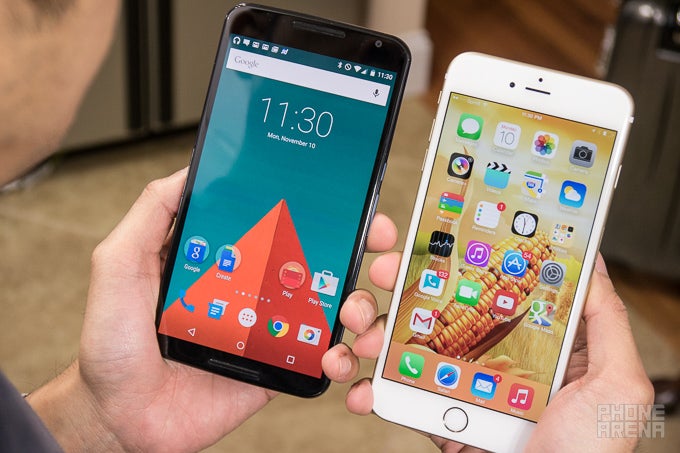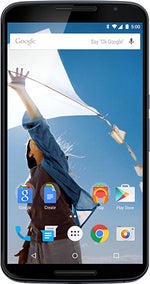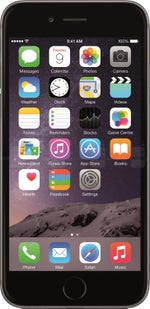Google Nexus 6 vs Apple iPhone 6 Plus

Introduction
For a good long time there, Apple was resistant to making really big phones – the kind that fit the mold of being a phablet. This year, however, they finally entered that new space with the iPhone 6 Plus. Arguably, it’s the beefier and more compelling iPhone for phablet lovers with its massive screen diagonal and all. Just arriving on the scene, however, the Google Nexus 6 is already making some serious noise with its fresh Android 5.0 Lollipop experience, so it’ll be intriguing to see how it can try to propel itself in reaching the same highly sought out status as Apple’s pride and joy.
Design
The Nexus 6 is far sturdier and more attractive than most other Nexus phones, but it still lacks the meticulous, premium finish of the iPhone 6 Plus.
We applaud the Nexus 6 for the sturdier construction and more appealing design it has over the Nexus phones of previous years, but in comparing it to the iPhone 6 Plus, it can’t quite match its premium finish. It’s simply plastic versus metal here, as the iPhone 6 Plus’ aluminum body exudes the more luxurious feel. However, when it comes to drops, we feel that the Nexus 6 would fare better – especially if these guys are impacting concrete or something hard. We already know that the iPhone 6 Plus is a handful to operate, but the Nexus 6 is bigger in every way – it’s wider, taller, thicker, and heavier.
Due to the premium finish of the iPhone 6 Plus, its power button and volume controls feel more solid – whereas the Nexus 6’s set are thin and less distinct. Over on the Nexus 6, we really appreciate that it features dual front-firing speakers, which are more ideal because they disperse audio towards us. Meanwhile, the iPhone 6 Plus differentiates itself by incorporating a Touch ID finger print sensor into its home button. Honestly, it’s a special amenity that has its usefulness in securing the device and making payments via Apple Pay.
Display
The Nexus 6 is impressive for its quad-HD resolution, but the iPhone 6 Plus has a brighter and more color accurate screen.
Knowing that they’re in that phablet space, we’re dealt with larger-than-normal screens here. Specs have a way of dictating things, which is evident here from a cursory look, as the Nexus 6’s 5.96-inch 1440 x 2560 AMOLED display trumps the iPhone 6 Plus’ 5.5-inch 1080 x 1920 Retina Display. Obviously, there’s a huge advantage with the Nexus 6 when it comes to pixel density, but in all fairness, it’s still tough to discern its superiority from a normal viewing distance – though, it becomes evident upon closer inspection.
Despite its amazing quad-HD resolution, the Nexus 6’s display lacks the same polished qualities we see in the iPhone 6 Plus’ Retina Display. For starters, visibility isn’t an issue with the iPhone 6 Plus because its screen emits a blinding 575 nits of brightness – far more potent than the 270 nit brightness of the Nexus 6. In addition, colors are more accurately reproduced on the iPhone 6 Plus. In contrast, the Nexus 6’s display exhibits excessively saturated colors. Those do look nice and jolly, but we tend to value accuracy more.
Overall, it’s a tough call which one comes off as more appealing. Of course, the Nexus 6 excels in the resolution department, but we can’t forget how the iPhone 6 Plus comes to the table with better visibility and precise colors.
Interface and Functionality
There’s no comparison whatsoever, Android 5.0 Lollipop is remarkable in every facet.
Apple no doubt brought its game to the table with the release of iOS 8, giving it some notable features that bring the experience to the same level as Android past. However, now that Android 5.0 Lollipop is here in the flesh, where it's being featured on the Nexus 6, the separation between the two platforms is once again apparent. It all boils down to the undeniable reality that Google is one step ahead in the functionality department. And with Lollipop, Google is also addressing many of Android's presentation issues.
The gap is plainly evident when it comes to the design language and software features of the respective platforms. Indeed, the two share the common element of employing a flat, layered design, but Google makes better use of transition effects and other miniscule animations to give Android 5.0 Lollipop a more dynamic feel. And best of all, it still continues to outdo iOS 8 when it comes to personalization.
Another area of great divide is seen in their set of software features. We won't deny that iOS 8 brought on new tools and tricks that diversified its experience to roughly the same level of Android, such as the case with its support of third party widgets and keyboard, but Lollipop elevates the experience to an even higher level.
For example, the option to pin/lock the Nexus 6 to run a certain app, as well as its support for multiple users, are software features that can't be found on iOS 8 on the iPhone 6 Plus. One thing we'll give Apple credit for, seeing that Lollipop doesn't have it, is the ability to shrink the interface at any time by lightly double-tapping on the home button. And, even with Lollipop's rich experience, iOS still presents itself with better looking and more functional third party apps.
Processor and Memory
Superficially, they’re buttery smooth, but the iPhone 6 Plus has a stronger gaming performance.
We can dissect their respective processors, but at the end of the day, the quad-core 2.7GHz Qualcomm Snapdragon 805 SoC with 3GB of RAM in the Nexus 6, and the dual-core 1.4GHz Apple A8 64-bit based chip with 1GB of RAM within the iPhone 6 Plus, produce nearly the same peppiness with all sorts of operations. Superficial processes are accompanied with snappy responses, but there’s a slight advantage to gaming performance with the iPhone 6 Plus.
Unfortunately, neither smartphone offers expandable storage to supplement their internal capacities. Specifically, the Nexus 6 is offered in 32GB and 64GB configurations, but the iPhone 6 Plus has more of a stretch, seeing that it’s available in 16GB, 64GB, and 128GB options.
Internet and Connectivity
Sure, the larger screen size of the Nexus 6 makes it a little bit more ideal for the web browsing experience, seeing that we’re able to see more of a page than we’d get on the iPhone 6 Plus, but the marginal quality is negligible. We will note, however, that with the introduction of Lollipop with the Nexus 6, web pages can now be displayed individually in the apps switching menu. Ultimately, we’ll mention that the two are no doubt fantastic for surfing the web.
The iPhone 6 Plus is notable for being a true world phone, one that supports more LTE bands than any other smartphone – leaving fewer variations of the phone needed to work with the assortment of networks littered around the world. That realization is made especially known looking at the Nexus 6, which has one model to support the US networks, and another for the international market.
Beyond that, they’re adorned with the same set of connectivity features we’d expect to find in any high-end phone. Specifically, they feature aGPS, Bluetooth, dual-band 802.11 a/b/g/n/ac Wi-Fi, and NFC.
Camera
On paper, the Nexus 6’s camera seems to have an advantage, but the results show that the iPhone 6 Plus is by far the stronger performer.
Running their respective camera apps, it’s notably evident that the two companies prefer a cleaner interface – one that’s light on shooting modes and manual controls. Quite simply, it all boils down to interfaces that focus on quickly snapping photos, without distractions. However, we will note that the Nexus 6 offers UHD 4K video recording – while the iPhone 6 Plus has a neat 240 FPS slow motion video capture feature.
Don’t be fooled by the iPhone 6 Plus’ 8-megapixel iSight camera, especially when it seems insignificant on paper to the Nexus 6’s 13-megapixel snapper, just because it’s far more versatile in capturing photos in their natural state. Sure, there’s a smidgen more detail with the Nexus 6’s camera, but the iPhone 6 Plus’ shots are sharper looking – with a more natural looking exposure. It’s especially noticeable with the sky in some of our shots, where clouds are indistinct looking due to the overexposure with the Nexus 6. At the same time, there’s more saturation in the colors of the Nexus 6 shots.
The biggest disparity is evident with their low lighting performances, as the iPhone 6 Plus blatantly shows us that it’s sporting the superior camera. Checking out the results, there’s just no hiding the fact that Apple’s product is far more capable under low light, seeing that its shots are brighter, crisper, and less noisy.
No doubt, we appreciate that the Nexus 6 is accompanied with UHD 4K video recording, but when comparing apples to apples with their 1080p samples, we’re again attracted to the quality of the iPhone 6 Plus. Essentially, it’s sharper looking, offers better exposure adjustment, and its auto-focus is spot on. Yeah, the 4K video recording of the Nexus 6 captures far more detail, but its 1080p video sample is softer in tone – plus, it has a tougher time adjusting/maintaining its focus.
Multimedia
Videos have a slicker look on the Nexus 6’s quad-HD screen, so it’s the device we’d stick with for the occasion.
Visually, Google’s Material Design is in full showcase with the update to the Google Play Music app – one that sports a bolder looking interface. In comparison, Apple’s music player is still visually pleasing, but it doesn’t have the same meticulous attention. Nevertheless, the functions between the two players are pretty much identical.
Even though the Nexus 6’s dual front-firing speakers is able to muster up 75 dB of audio power, higher than the 71.6 dB output from the iPhone 6 Plus’ single speaker, its bass tones sound a bit reserved. Conversely, the quality from the iPhone 6 Plus speaker is crisper in tone.
The over-saturated color reproduction of the Nexus 6’s quad-HD AMOLED display lends its usefulness when it comes to watching high-def videos, seeing that it sprinkles that level of iridescence and glow that make videos come to life. Well, the video watching experience on the iPhone 6 Plus isn’t bad, but we like it more with the Nexus 6.
Call Quality
Average, that’s the performance out of the two phones here.
We actually don’t find one phone being more superior for phone calls, especially when we feel that their qualities are more average. Voices for the most part are audible through their earpieces, but there’s some static noise through the Nexus 6. Meanwhile, the iPhone 6 Plus’ speakerphone has a subdued tone to it.
Battery
Forget about it, the Nexus 6 flexes its muscles by delivering longer battery life.
Normally, a super high-resolution screen combined with a beefy processor under the hood would be taxing when it comes to battery life, but that’s not the case as we find the Nexus 6 dishing up the superior battery life. Our battery benchmark test sheds light on that certainty, as the Nexus 6 achieves a mark of 7 hours and 53 minutes from a full charge – whereas the iPhone 6 Plus taps out at 6 hours and 32 minutes. Not stopping there, the Nexus 6 also features built-in wireless charging, which is an especially inviting treat for any high-end phone. Without a doubt, the bigger, 3220 mAh juicer of the Nexus 6 proves to be quite useful; it's a bit unfortunate that Apple only managed to fit a 2915 mAh battery.
Conclusion
With the holidays around the corner, the competition will no doubt continue to build up, as these two prized smartphones will attempt to claim victory over one another. History has already shown to us that the iPhone 6 Plus is a hot selling smartphone. Now that the Google Nexus 6 is finally available for purchase, all eyes are on the device to see how it can disrupt the iPhone 6 Plus’ momentum.
In terms of pricing, there’s an advantage going with the Nexus 6 and its lower $649 cost, which is noticeably cheaper than the $749 starting cost of the iPhone 6 Plus. Taking into account the quad-HD screen it’s packing along, it’s pretty impressive to see it undercut Apple’s offering in that area. Additionally, with the introduction of Android 5.0 Lollipop, which is increasingly transforming Android into a more consistent and versatile software package, it helps to solidify the Nexus 6’s usefulness and value.
However, we can’t forget to mention the premium nature that’s attached to the iPhone 6 Plus. That alone helps to justify its higher cost, but it also helps that it captures the better looking photos and videos with its camera. Indeed, iOS 8 doesn’t have the same breath of software tricks and features we get with Android 5.0 Lollipop, but the experience does have its advantages, such as its extreme level of polish and intuitiveness. It’s a tough call on which one to go with, but we can certainly say that you won’t be disappointed going with either of them.


























Things that are NOT allowed: